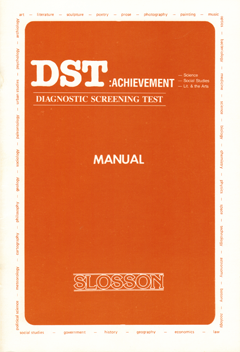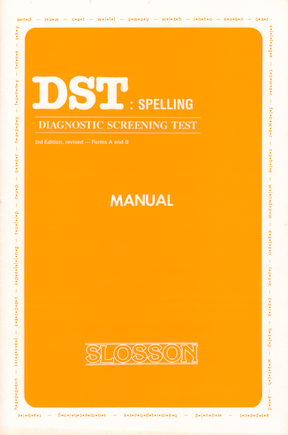Order the Entire DST Battery and Save!
Diagnostic Screening Test: Language - Second Edition
Quantity Instructor Discount Available for the DSTL.....Refer to Promos Page
The DSTL is designed as a quick, valid method for estimating overall achievement level in written language and more specifically, skill mastery in grammar, punctuation, capital-ization, sentence structure and formal spelling rules. The student’s over-all achievement level is divided into formal knowledge (rote rule knowledge) and applied knowledge (skill in habitual correct usage, separate from ability to state formal rules).
Three Ways to Administer the DSTL:
1. Examiner can read questions while subject listens only:
most useful in kindergarten and early first grade. The examiner may repeat both question stems and foils up to three times if necessary (at students’ request and/or if deemed reasonable).
2. Subject may read test by him or herself: Generally reliable for children beyond fourth grade reading levels. (In this case, as in any of the methods, the examiner may pronounce any words the student asks to have pronounced, but may not define or illustrate any words.)
3. Subject may read along and mark his/her copy while examiner reads items aloud: Recommended as the most reliable (except for students with known or suspected “dual channel” confusion problems).
Scoring:
Begin by plainly marking each incorrect answer and refer to the end of the manual containing a removeable scoring template. As in most tests, the basis of all scores used in the interpretation of the DSTL results is the raw score (RS). In this case the RS is a simple sum of the items correct. Eight raw scores are necessary to obtain the various categorical scores summarized on the front page of the Test Form: total number correct on each of the five sub-tests; the sum of the correct Applied items; the sum of the correct Formal items; and the sum of all items correct on the entire test.
Consolidation Index (CI) Computation:
The Consolidation Index (CI) reflects how solid or spotty a student’s knowledge or skill is. The total number of correct res- ponses up through the Grade Equivalent point is divided by the total number correct in the entire test or sub-test. The larger the CI score, the more consolidated the skill.
Interpretation of Data:
The basic question directly answered from the data relates to what level of achievement a given student has attained in Written Language Skills. This can be further analyzed into achievement levels in five major sub-areas of Written Language: Punctuation, Spelling Rules, Sentence Structure, Grammar and Capitalization. The Total Language Score can then be described in terms of the student’s level of competence when dealing with the Formal Rules involved (relatively abstract, rote knowledge of reasons behind the processes) and when dealing with the Application of Procedures (the more habitual and practical side, not necessarily related mean- ingfully in the student’s mind to rules or reasons). These scores can be compared with one another to suggest weaker and stronger areas needing more or less emphasis in the student’s course of study.
Test Construction:
From major references on the English language, lists of over 200 rules were prepared and divided into five generally accepted sub-areas (Punctuation, Spelling Rules, Sentence Structure, Grammar and Capitalization). From these list of rules, more than 200 questions were written with at least one question covering each rule. Initially each item was written at a language level most likely to be appropriate for the grade level of the students where the rule was typically introduced. These questions were then circulated to experienced language teachers at all developmental levels.
Thomas D. Gnagey / Patricia A. Gnagey
Grades: 1 through 13
Administration: Individual or Group Setting











